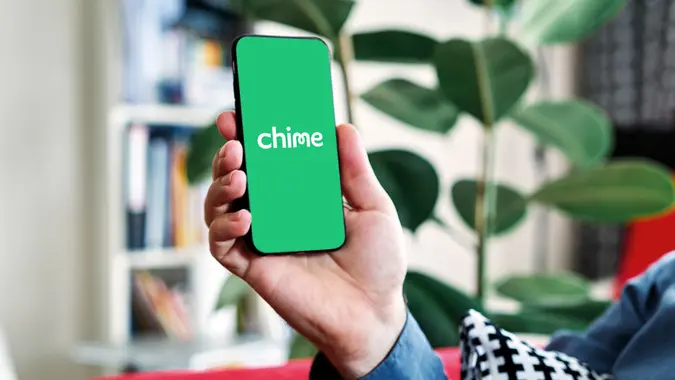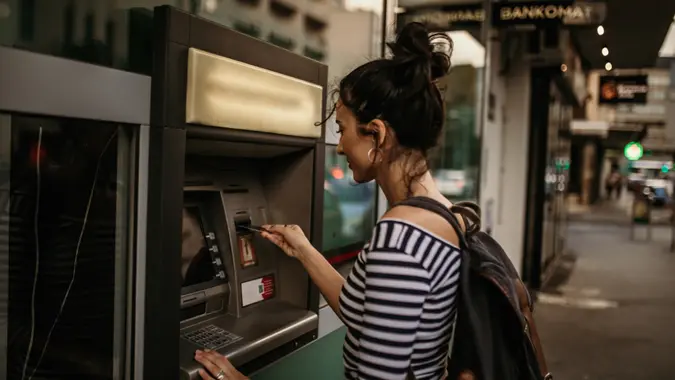International Wire Transfers: How to Send Money Abroad Safely

Commitment to Our Readers
GOBankingRates' editorial team is committed to bringing you unbiased reviews and information. We use data-driven methodologies to evaluate financial products and services - our reviews and ratings are not influenced by advertisers. You can read more about our editorial guidelines and our products and services review methodology.

20 Years
Helping You Live Richer

Reviewed
by Experts

Trusted by
Millions of Readers
Every year, over $500 billion is transferred between countries across the globe through secure international money transfers. People send money to family, for business transactions and unexpected travel expenses.
The key factors for international money transfers are speed, cost, security and exchange. Before wiring money abroad, it’s a good idea to understand how international money transfers work.
Here’s a closer look at the process, along with five of the best ways to electronically move money to foreign countries.
Why Send an International Money Transfer?
People send international funds for all kinds of reasons. Maybe you’re supporting family members, paying tuition at a foreign university, or closing on a property abroad. No matter the purpose, you want a transfer method that hits the sweet spot for cost, speed and security.
Key Factors To Consider:
- Speed: How fast does the recipient need the money?
- Cost: Are you willing to pay a bit more for instant transfers, or do you prefer a cheaper option if it takes longer?
- Security: Does the provider have a strong reputation and encryption?
- Exchange Rates: A poor rate can wipe out any savings you get on fees.
- Limits: Check if your chosen method has daily or monthly caps.
How to Send an International Money Transfer
It isn’t complicated to send an international money transfer. You need to follow this step-by-step guide:
Step 1. Choose Your Transfer Method
Here are the four different ways to transfer funds internationally:
- Choose a bank wire: A bank wire is typically a secure way to send money internationally, but can be slow and expensive.
- Use an online service: Those who want to avoid bank fees may choose an online service like Wise, Revolut, Remitly and Xoom, all of which can be fast and have lower fees.
- Opt for a cash transfer service: Cash transfer services like MoneyGram and Western Union will allow physical pickup of funds.
- Move forward with a cryptocurrency transfer: Some may use bitcoin to do an international transfer.
Step 2. Gather Recipient Details
You will need the specific information to send your international transfer. Here is what you may need:
- Recipient’s Full Name: It should be the name as it appears on their bank account.
- Bank Name and Account Number: For bank transfers, you need the recipient’s bank name and account number.
- SWIFT/BIC Code: SWIFT codes are generally needed for international wire transfers to a bank.
- Country and Address: Services from Western Union will require a country and address.
Step 3. Compare Transfer Fees and Exchange Rates
When sending your transfer, you will likely compare transfer fees. Generally banks charge more than online services. Read the fine print when considering transfers.
Step 4. Initiate the Transfer and Confirm Details
You can log in to the service of your choice. Initiate the transfer and enter the recipient’s details carefully. Double check the information before you fund your transfer. You can use a bank transfer, credit or debit card or a cash deposit. Confirm your transaction.
Step 5. Track Your Status
Many services use a tracking number to help you check the status of your transfer. If any delays occur, immediately contact the service you used.
Best Ways to Send Money Internationally
| Method | Fee Range | Speed | Best For |
|---|---|---|---|
| Bank Wire Transfer | $25-$50 | 1-5 business days | Large, secure transfers (>=$10k) |
| Online Transfer Services | Varies, often low | Minutes to 1 day | Regular cross-border payments |
| Cash Transfer Services | Higher (varies) | Instant to 1 day | Recipients needing cash pickup |
| International Money Orders | Usually <$10 | 1-2 weeks (mail) | No bank account needed, small sums |
| Cryptocurrency Transfers | Exchange & network fees | Minutes to hours | Tech-savvy, stablecoin usage |
(Fees and speed can fluctuate based on provider, country and special promotions.)
1. Bank Wire Transfers
Do you want to transfer a large amount of funds internationally? A bank transfer may be ideal for larger transactions.
- How it works: You can initiate a wire transfer from your bank by providing the recipient’s details including the full name, account number and SWIFT code. The SWIFT code is used for international wire transfers to ensure the money reaches the correct bank. The number consists of eight or 11 characters that will include letters and numbers, The SWIFT code is may be published on the bank’s website or your can customer service for the code.
Pros of bank transfers
- Secure and widely accepted among individuals and institutions.
- Making direct-to-direct bank transfers discourages fraud.
- Ideal for large and business transactions.
Cons of bank transfers
- High fees.
- Longer processing times (may take up to five days).
- Poor exchange rates compared to online transfer services.
2. Online Money Transfer Services
If your loved one needs money fast, an online money transfer service may be ideal for a cost-effective transfer that will reach the recipient quickly. Online money transfer services generally have lower fees.
- How it works: Several platforms are available. You can use Wise, PayPal, Revolut, Xoom and others. You can initiate the transaction online or via an app. You will simply follow the prompts to process your international transfer.
Pros of online transfer services
- Competitive exchange rates.
- Faster than bank transfers.
- More convenient than going in person to a bank.
- User-friendly interfaces.
Cons of online transfer services
- Some services may have limits on transfer amounts.
- There may be additional charges for funding the transfer with debit and credit cards.
3. Cash Transfer Services
Some recipients may not have a bank or may need quick access to cash funds. In those cases, cash transfer services like Western Union and MoneyGram are a good fit. These services are especially ideal for recipients who need cash fast.
- How it works: Senders can select payment methods like cash, bank transfer, debit or credit card at the agent location. Sender will provide the recipient’s full name and pickup location. Recipients can collect the cash at a local branch.
Pros for cash transfer services
- Many services are set up to deliver cash to the recipient instantly.
- A bank is not required for the recipient.
- Cash transfer agent locations are widely available.
Cons for cash transfer services
- Cash transfers generally cost more than bank transfers.
- Cash transfer services generally markup currency conversions so this added cost is passed along to the sender.
- Money cannot be refunded if picked up by the wrong person.
4. International Money Orders
International money orders are a safe and secure way of sending money internationally. This is a great way for those who don’t have banks to have the opportunity to send money across continents.
- How it works: You can visit a post office, bank or financial institution to purchase a money order. You fill out the purchase order in the name of the recipient and mail it internationally. The recipient can cash a money order in their country.
Pros on international money orders
- No need for a bank account.
- A money order can be replaced if lost or stolen.
- There are no rate fluctuations on money orders.
Cons on international money orders
- Slow processing times because of postage delays.
- Some countries don’t accept money orders.
5. Cryptocurrency Transfers
If the recipient of an international money transfer has a crypto wallet, they are a good candidate to receive a cryptocurrency transfer. It is a fast and private way to send an international transfer without an intermediary.
- How it works: You buy cryptocurrency like Bitcoin or USDT and send it to the recipient’s wallet, where they can convert it into local currency. The recipient can convert crypto to local currency via an exchange or keep it as crypto.
Pros on cryptocurrency transfers
- The transactions are fast. Sometimes these transfers can be completed within minutes or hours.
- Sending cryptocurrency has lower fees.
- You can send cryptocurrency 24/7.
Cons of cryptocurrency transfers
- There is price volatility with cryptocurrency.
- Cryptocurrency is not a universal payment method.
- If the recipient loses their crypto wallet or private key, funds will be lost.
How Long Does It Take To Send Money Overseas?
- Bank Wires: Usually 1 to 5 business days. Domestic wires can post same-day, but for overseas, 2 to 3 days is common.
- Online Platforms: Could be instant if the recipient also uses the same service, or 1 to 2 days if it’s a bank transfer.
- Cash Services: Many offer near-instant pickups, but you might pay more for this.
- Money Orders: Possibly a week or more, given mailing time.
- Crypto: Often minutes, depending on the blockchain’s network congestion.
Weekends, holidays or missing info can cause delays, so plan accordingly.
Final Take to GO
Figuring out the best way to send money overseas in 2025 depends on your priorities: speed, cost, convenience, and the recipient’s access to banking. If you need a tried-and-true approach for high amounts, an international wire transfer from your bank might work. If cost and speed are top concerns, an online transfer platform might be the winner. For smaller sums or no bank account, a cash service or money order can do the trick.
You’ll want to:
- Compare at least two or three services to find the best way to transfer money internationally for your specific needs.
- Check out your bank’s or chosen platform’s current exchange rate to avoid surprises.
- Finally, confirm all recipient details — typos cause delays and potential fees.
With this guide, you’ll be set to pick the best way to send money internationally — and ensure your funds land safely in the right hands.
FAQs About International Money Transfers
Figuring out digital banking can be difficult, especially if you're not particularly familiar with the ins and outs of how it works. With that in mind, here are some common questions and concerns that might pop up while looking into it:- What is the cheapest way to send money internationally?
- Wise (formerly TransferWise), Revolut and Remitly offer low fees and competitive exchange rates compared to traditional banks.
- Can I send money overseas without a bank account?
- Yes. You can use Western Union, MoneyGram, PayPal, Wise or prepaid debit cards to send money without a bank account.
- What is the best app for international money transfers?
- Wise, PayPal, Revolut, Xoom (by PayPal), and Western Union are among the top-rated apps for international transfers.
- Are international wire transfers refundable?
- Generally international wire transfers are not refundable, unless there is evidence of fraud or error that the bank can verify.
- Do international transfers have limits?
- Yes. The limit depends on the provider.
Information is accurate as of March 7, 2025.
Editorial Note: This content is not provided by any entity covered in this article. Any opinions, analyses, reviews, ratings or recommendations expressed in this article are those of the author alone and have not been reviewed, approved or otherwise endorsed by any entity named in this article.
Editorial Note: This content is not provided by any entity covered in this article. Any opinions, analyses, reviews, ratings or recommendations expressed in this article are those of the author alone and have not been reviewed, approved or otherwise endorsed by any entity named in this article.
Our in-house research team and on-site financial experts work together to create content that’s accurate, impartial, and up to date. We fact-check every single statistic, quote and fact using trusted primary resources to make sure the information we provide is correct. You can learn more about GOBankingRates’ processes and standards in our editorial policy.
- Consumer Financial Protection Bureau "Money transfers"
- USPS "Sending Money Internationally"
- Western Union "Send Money Abroad Quickly & Securely"
- Federal Communications Commission "Wire Transfer"
- National Institute of Standards and Technology "Blockchain"
 Written by
Written by  Edited by
Edited by 

























